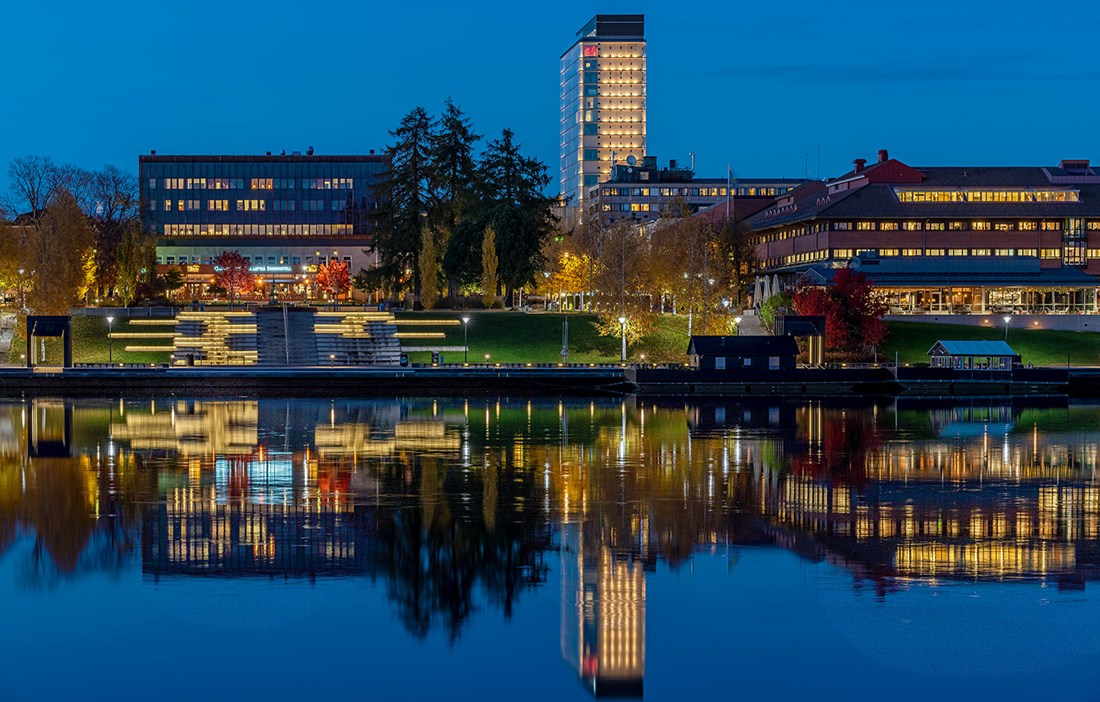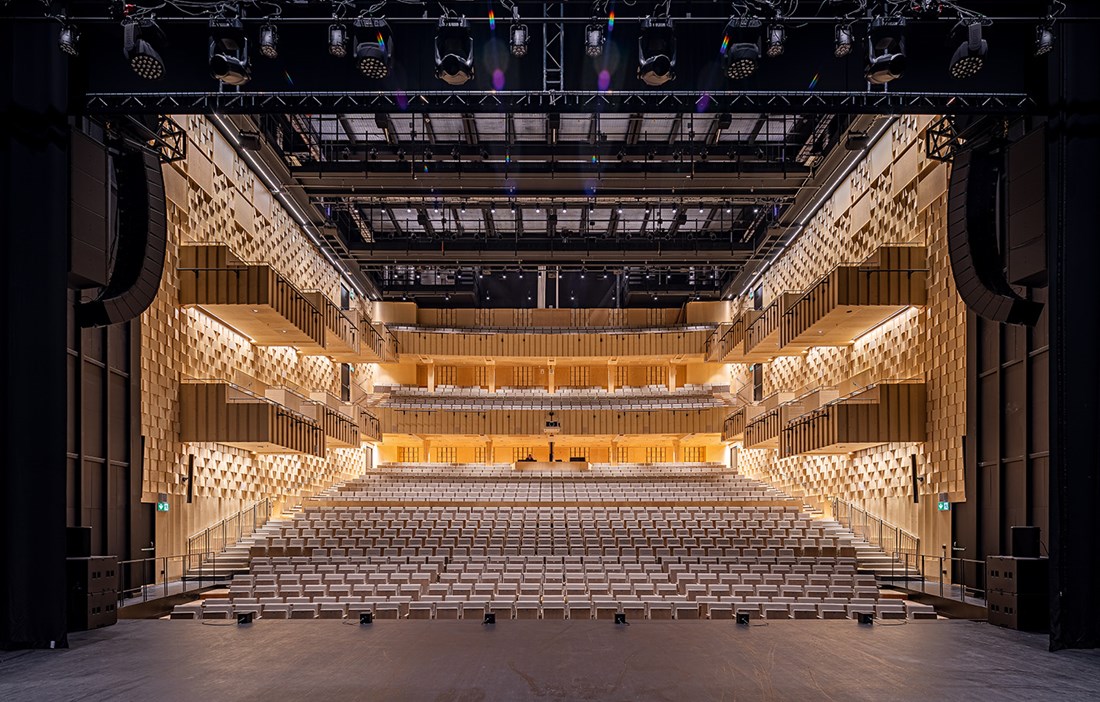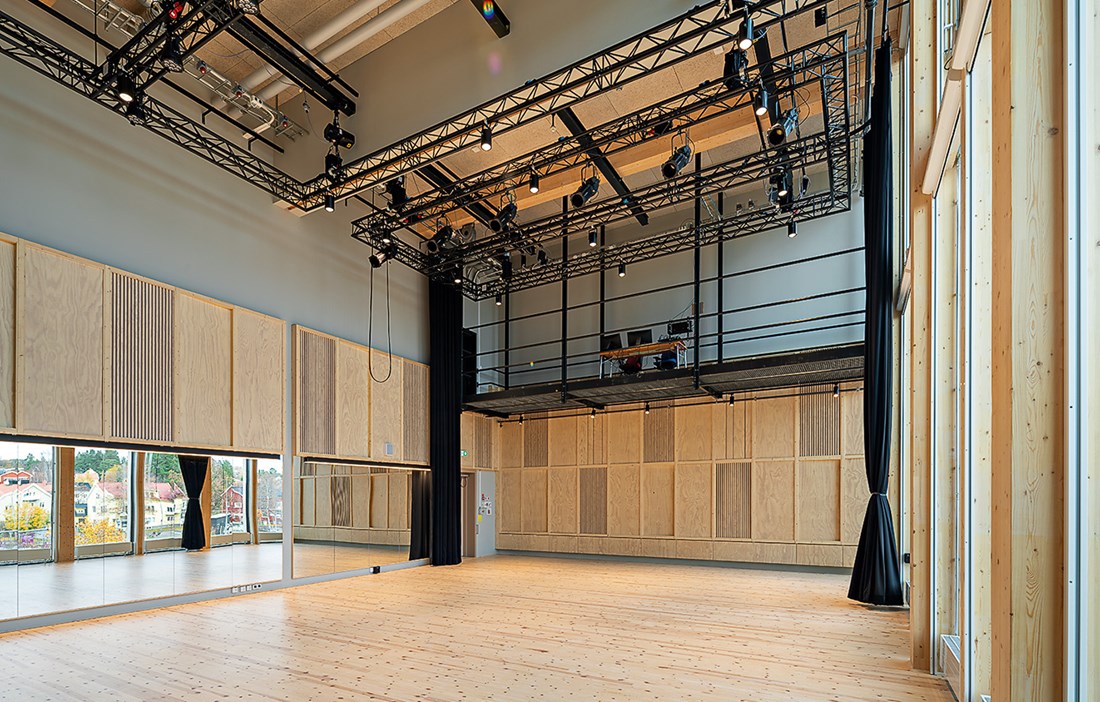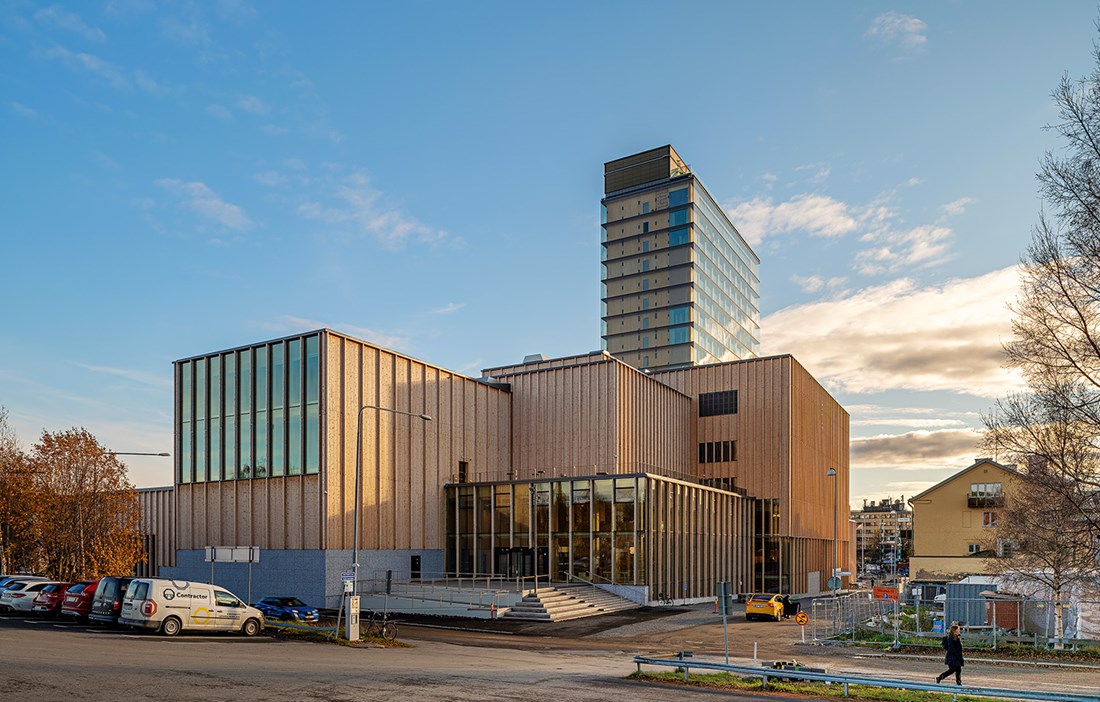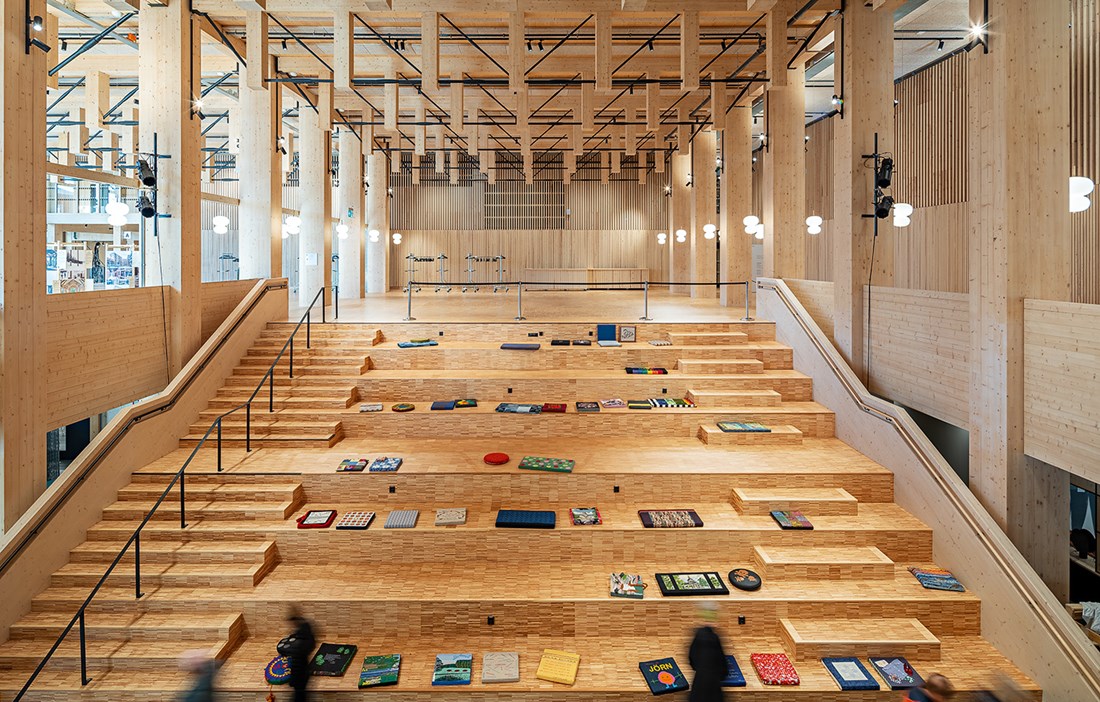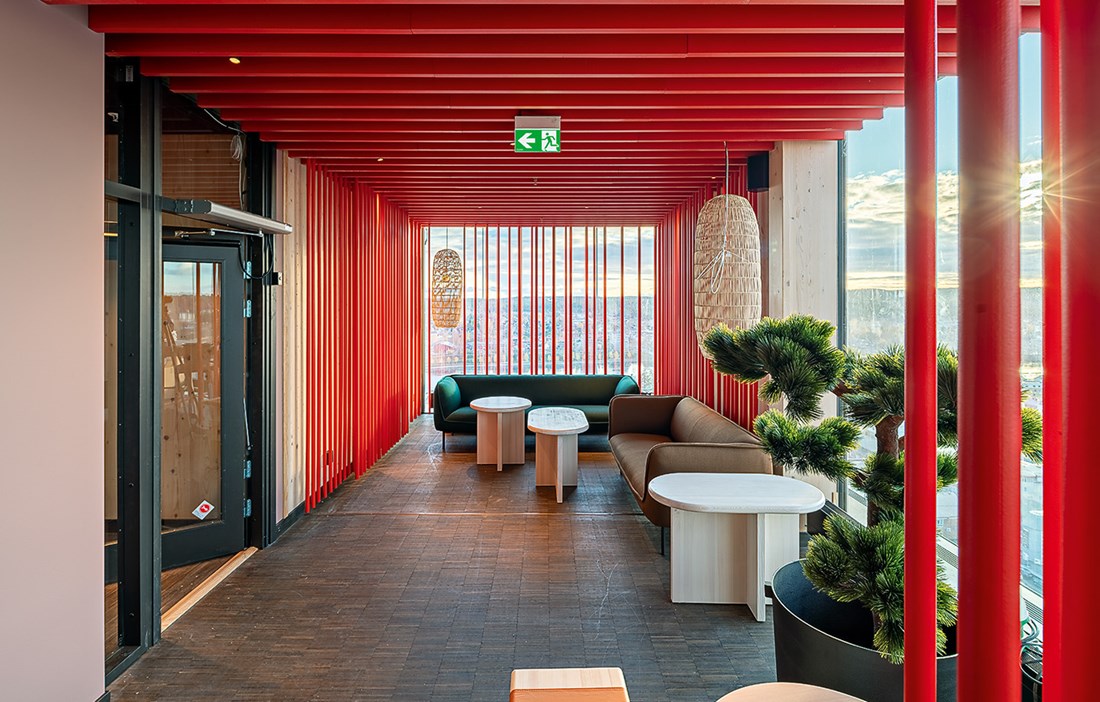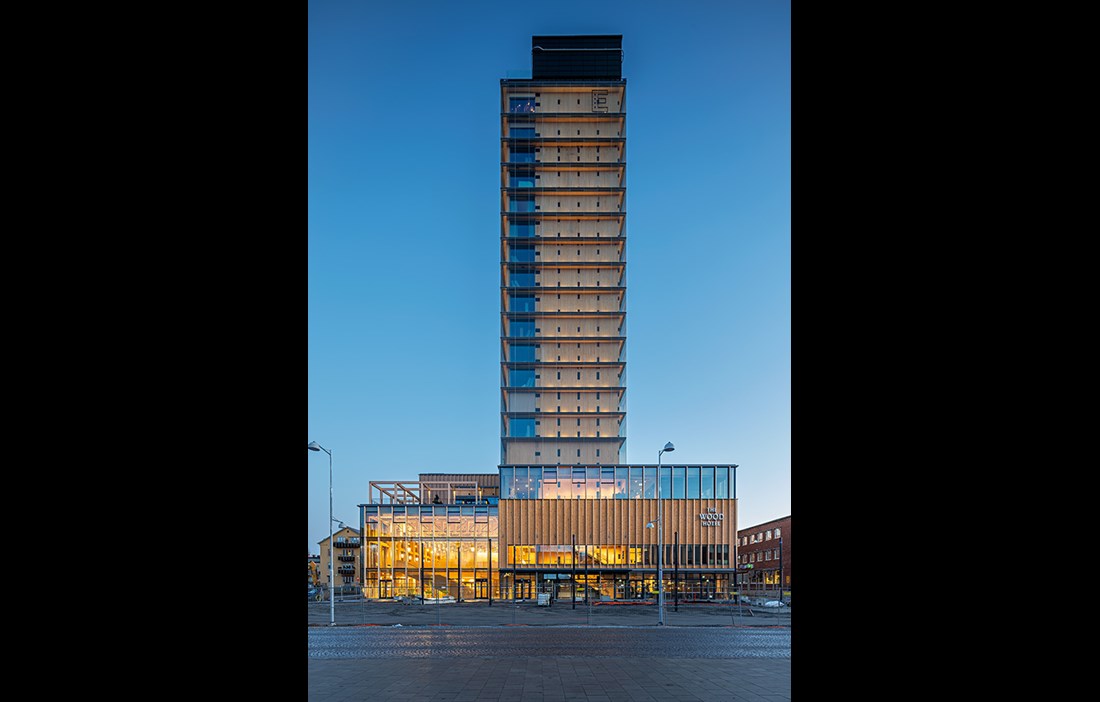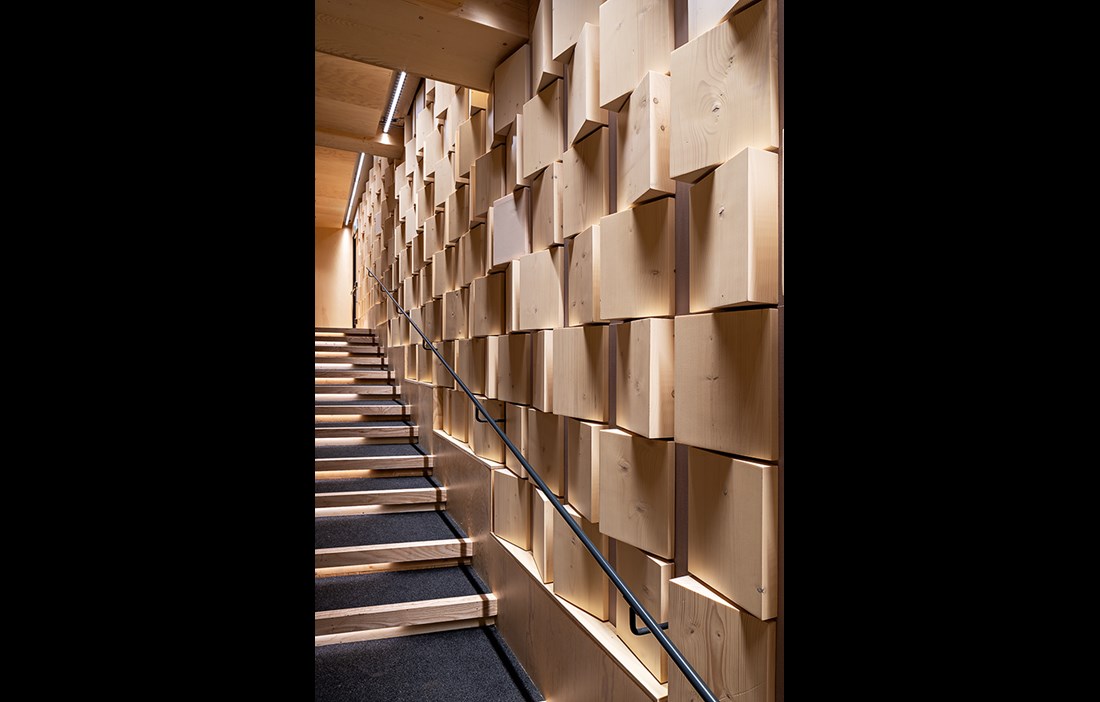Sara Kulturhus opened on 8 September 2021. At a height of 75 metres, it stands as one of the world’s tallest wooden buildings, and as a testament to the close collaboration between several local stakeholders. The arts centre occupies a whole block between Möjligheternas Torg and what will be the city’s new travel hub. But what makes the centre unique is not only the height and scope of the project, but also the way it has managed to gather so many different activities and uses under one roof. Now the City Library, Museum Anna Nordlander, Skellefteå Konsthall and Västerbottensteatern are ready to welcome their audiences and visitors. The building also houses the Wood Hotel, which has 205 rooms, three restaurants, a spa, gym and conference facilities.
Maria Ekberg Brännström is CEO of Sara Kulturhus and has been one of the driving forces in realising the vision for Skellefteå’s new landmark. According to Maria, the building embraces sustainability on several fronts – not just because it is made of wood throughout, but also because of how the different parts of the building can be used in so many ways.
»This really is a building of possibilities. The stages can be transformed to suit different activities, and the other spaces can be integrated with and separated from each other for the greatest possible flexibility.«
It was in June 2015 that the City Council in Skellefteå decided to build a new arts centre. An open architectural competition was launched in November of that year, attracting 55 entries. White Arkitekter won with their design ‘Side by Side’. The project has required a number of innovative solutions to handle the spans, flexibility, acoustics and the overall technical challenge that comes with building one of the world’s tallest wooden structures. The solutions have included two separate construction systems, one for the arts centre and one for the hotel.
The lower section of the building, which houses the arts centre, comprises a prefabricated structural frame in CLT and glulam. The diversity of the activities and providers is reflected in the architecture, with the building given different volumes that are adapted in shape and size for the various activities. At the same time, Sara Kulturhus has been designed with flexibility in mind, so the spaces can easily be reconfigured to accommodate different uses and future needs.
»The building has been tailor-made for the operations that have now moved in. But at the same time, it has a generality that opens up all sorts of other opportunities. The large stages are placed in a row at the heart of the building. Around them, we have then worked with the various operations that face out onto the street, creating a more vibrant streetlife. The aim has been to give the building engaging fronts rather than off-putting rear faces,« explains Robert Schmitz, who joins Oskar Norelius as the lead architects for the project at White.
The arts centre’s large, open foyer to the south is a huge space that, despite its size, feels warm, comforting and inviting. The large glulam posts and the ceiling’s stylish supporting structure in wood and steel hold up not just the roof, but also the 20-storey hotel section.
»The foyer is designed as a sequence of rooms from which you can reach all the facilities. The roof trusses enable spans of over 20 metres and are an example of material optimisation, where wooden braces take the compression and the steel ties take the tension. This architectural feature is an important factor in defining the space. The dimensions of the braces match their function and the scale of the room,« continues Robert Schmitz.
The foyer leads to the arts centre’s stages and exhibition spaces. Having all the stages and the foyer on the same level allows for large, connected events. The impressive multi-use staircase leads down to the main entrance and the City Library, forming a kind of internal path connecting the foyer with the north entrance. Gathered along the east wing, the building’s administrative offices are connected via a three-storey corridor that enables the cultural workers to meet behind the scenes.
Västerbottensteatern’s Chief Executive Director Fransesca Quartey
» I WANT TO TOUCH THE WALLS AND ENJOY THE SCENT OF WOOD.«
The county theatre Västerbottensteatern has waited a long time to move into Sara Kulturhus. The autumn saw a flurry of premières, with the curtain going up on attractions such as the world première of The March of the Musicians, plus The Storytelling Festival and a packed programme of guest performers, artistic talks and other events.
»This building is like a church in the middle of the village or, as writer Sara Lidman put it, the village at the centre of the world. Although the centre is large and flexible, it has to be said that combining productive art and organised events poses certain challenges. To make it work, we need to establish good communication channels and show respect for each other’s special character,« says Fransesca Quartey, who has headed Västerbottensteatern since 2013, when she was tasked with leading its move into Sara Kulturhus.
In all, Sara Kulturhus has six stages of varying sizes, from the largest stage with a ceiling height of 15.5 metres and an audience capacity of up to 1,200 seated guests, to the smaller lecture theatre with its 50 seats. Stage 1 is the largest and meets the Swedish National Touring Theatre’s red standard. It is designed for a broad programme of events, including theatre, musicals and congresses. The stage can be separated off from the auditorium, and the front rows of seats can be lowered into the basement or into a wall for a more flexible space. There is also an orchestra pit where the entire seated orchestra can be raised or lowered.
Stage 2 is what the industry calls a black box theatre, with audience capacity of 292, and it is here that many of Västerbottensteatern’s larger productions will be staged. The black box theatre is a modern, more flexible interpretation of the performance space, often painted black and with no fixed furniture. At Sara Kulturhus, the walls are painted in a dark petrol green that is reminiscent of ancient forests. When you move away from the traditional, fixed division between stage and audience seating, the performance space can be varied from one production to the next. The other stages have a capacity of between 50 and 100, making them ideal forstorytelling events, performances for children and schools, music and talks.
»We’ve been talking about the building for a long time. Now we have to look inwards to get to know it and use it to its full capacity. I’m a tactile person, and I can feel what a positive effect coming into this building has on me. I want to touch the walls, with their appealing lightness, and I enjoy the scent of wood. It feels warm and comforting, which bodes well for the journey we’ll be taking together with our audiences and the centre’s visitors,« says Fransesca Quartey.
White worked with Brekke & Strand as specialists in acoustics in wooden buildings. This led to solutions that combine highly effective sound insulation between the arts centre and the hotel with the right acoustics in the auditoriums. A prime example of this is the walls in the largest auditorium, which are clad in solid blocks of spruce with a triangular cross-section, made by the Spanish company Frapont. The wooden blocks have been arranged in a 3D parametric morphology that contributes to good room acoustics by reflecting the sound in every direction.
»To counter the wind loads, in static terms the tall hotel section has to be supported against the underlying art centre, which has brought considerable challenges for sound insulation. We worked on this in close collaboration with the structural engineers at TK Botnia, who developed steel connectors that are fixed between the wooden elements. The same is true for the hotel modules, which are joined together using steel screws and have been fitted with a sound damping intermediate layer,« says Kjell Nordmark, senior acoustician at Brekke & Strand.
The walls between the auditoriums are split into three sections, joined by an acoustic seal that runs from the basement to the roof. The outer part of the wall stands on a concrete slab and the inner part rests on posts, thus separating the load-bearing functions. This makes sure that the activities do not affect each other acoustically, meaning that a rock concert and a poetry reading can take place side-by-side.
David Åberg was quick to accept the job of managing The Wood Hotel. He sees it as a dream project and looks forward to creating inspiring experiences for the hotel’s guests, with the building itself playing an important role in that. Our aim is to offer our guests one of the world’s most sustainable hotel experiences, and naturally the material is a key factor, affecting both the quality of the accommodation and how a stay leaves our guests feeling. Personally, I find a different kind of calm in our 205 hotel rooms that are made entirely in wood. They provide a warm embrace and superb acoustics.«
It was decided early on in the project that 13 of the 20 storeys in the hotel section would be built from prefabricated 3D modules in CLT, produced at Derome’s housing factory in Renholmen, just outside Skellefteå.
»The hotel has become a signature feature of the arts centre, due to its location in the high-rise tower. Here, we’ve turned the building inside out and opted to highlight what others choose to hide, which in this case is 75 metres of 400-millimetre thick CLT sheets,« says Robert Schmitz.
The material for the modules was taken from forests in the region and processed by Martinsons in nearby Bygdsiljum, before being transported to Derome for assembly. The rooms were then delivered to the construction site almost fully complete, with a bathroom, windows, ventilation, electricity and the plumbing for sprinklers. They were then stacked on top of each other between two lift shafts, also made of CLT.
CEO Maria Ekberg Brännström
» SARA KULTURHUS IS NEITHER NEEDY OR COY.«
»With the project’s schedule so tight, the industrial approach, with more time in the factory and less time on the construction site, has brought major benefits. The big challenge was to get traditional builders and external project planners on board. They needed to get up to speed on modular construction and find solutions that allowed as much as possible to be prefabricated off-site,« comments Per-Olof Landstedt, business planner at Derome.
Level 19 of The Wood Hotel is the location of the Miss Voon restaurant, with its panoramic views and sky bar. Seating around 70 diners, the restaurant combines the flavours of Asian cuisine with the fundamentals of Scandinavian cooking. The interior, which also draws on Asian and Scandinavian influences, was designed by architect Thomas Sandell, who grew up in Skellefteå. With his stamp on it, the hotel hopes to make Miss Voon a destination in itself.
»The interior design follows the concept we worked on when setting up previous Miss Voon restaurants in Stockholm and Uppsala, with Chinese red wooden poles used as a recurring feature. The red brings a warm and inviting atmosphere and serves as a contrast with all the wood. It also works really well in both daylight and evening light, something we had to pay extra attention to in Skellefteå, where it is dark for one half of the year and light for the other half,« says Thomas.
In her role as CEO of Sara Kulturhus, Maria Ekberg Brännström has primarily chosen to create a place where everyone feels at home and can find something to like and discover, whatever their interests.
»Although the building is neither needy or coy, it has attracted a great deal of attention, not least from international journalists. Performers also love Sara Kulturhus and are happy to travel further north just so they can perform on one of our stages.«

